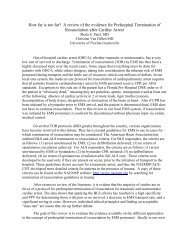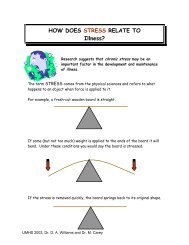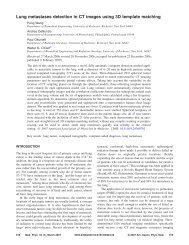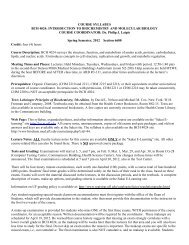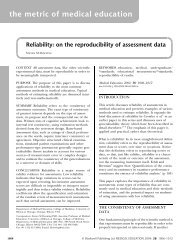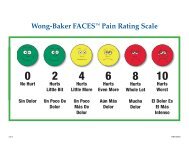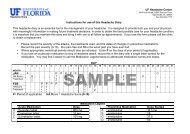imaging three-dimensional cardiac function - Walter G. O'Dell, PhD
imaging three-dimensional cardiac function - Walter G. O'Dell, PhD
imaging three-dimensional cardiac function - Walter G. O'Dell, PhD
Create successful ePaper yourself
Turn your PDF publications into a flip-book with our unique Google optimized e-Paper software.
Annu. Rev. Biomed. Eng. 2000.2:431-456. Downloaded from arjournals.annualreviews.orgby UNIVERSITY OF ROCHESTER LIBRARY on 07/27/09. For personal use only.?IMAGING 3-D CARDIAC FUNCTION 437the image data for 10–14 temporal images at a single slice location in the heartcan be acquired within a 16- to 20-s breath hold. Breath holds of this duration arefeasible in <strong>cardiac</strong> patients, even those with acute myocardial infarction (3). Theacquisition of cine data for 8–10 short-axis slices thus requires ∼10–15 min, allowingfor patient recovery after each breath hold. Newer sequences, using SMASH(simultaneous acquisition of spatial harmonics) for example (24), can cut this timeby a factor of 2 or 3. MRI can also be used to perform retrospective respiratorygating with navigator echo signals from the diaphragm, although the implementationof this technique is difficult (25). A recent review of MRI applied to <strong>cardiac</strong>motion analysis by McVeigh (25) is highly recommended.LV volume, ejection fraction, and wall thickness are perhaps the most frequentlyused indices of <strong>cardiac</strong> performance and patient prognosis (26, 27). However, thepertinent geometric information must first be extracted from the images before 3-Dsurface reconstruction. The challenge is to detect, within the image, heart contourfeatures that are irregular in shape and position, changing with time, and varying incontrast and whose image intensity gradient profile can change in both magnitudeand sign. Contour segmentation is the most laborious and error-prone part of mostanalysis schemes. Real-time clinical application of modern 3-D <strong>cardiac</strong> mechanicstechniques is going to require faster and better automated segmentation. We referthe reader to the article in this volume of Annual Review of Biomedical Engineeringthat pertains to image segmentation, by Pham et al (27a).LV wall thickness measurements have been linked to regional ischemia (27) andlead to estimates of mean wall stress (28) and mean wall stiffness. Wall thicknessmeasurements were made as early as 1964, by X-ray angiography (4), but morerecently Jakob et al (29) improved the technique by using injected-contrast anddigital-subtraction angiography. In comparison with the more commonly used M-mode ECG, the Jakob method showed good agreement towards end-diastole butpoorer agreement at end-systole.Although wall thickness changes are often the most apparent geometric indicatorof altered mechanical <strong>function</strong> (30), the relationship between wall thickness and<strong>cardiac</strong> health is not as clear. Significant correlations were found by Lawson et al(31) between thallium uptake and systolic wall thickness in ischemic hearts, but notwith diastolic wall thickness and thallium uptake (31, 32). Similarly, Curiel et al(33) found that the magnitude of inotropic reserve is not related to diastolic wallthickness or to basal systolic wall thickening. Heupler et al (34) showed that theLV end-diastolic cavity diameter, not wall thickness, was associated with thalliumperfusion defects and therefore myocardial ischemia. Dong et al (35) concludedANALYSES OF VENTRICULAR SIZE AND GEOMETRYWall Thickness Measurements



